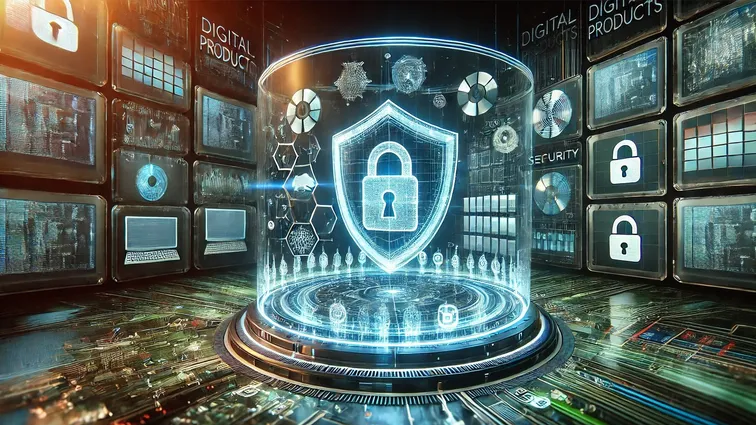Counterfeiting and unauthorized access to authentic products are growing problems that brands across all industries are grappling with. It goes beyond importation of fake handbags and sale of counterfeit paintings falsely attributed to famous artists. The EUIPO has published a clear guide on the ACAPT (Anti-Counterfeiting and Anti-Piracy Technology) platform, outlining the various technologies that offer different forms of protection. This article examines the tools used to protect digital products.
Digital products are products that are distributed as digital files or made available online. Eexamples include audio/video files (such as MP3 and MP4), e-books, databases, video games, and even the very article you are reading now. These products do not require a physical carrier, which has both advantages and disadvantages. A key disadvantage is the lack of physical security measures, such as embedded chips, barcodes, or holograms, that are commonly used to protect physical products.
Digital anti-counterfeiting technologies often rely on embedding identifying information into files, enabling content tracking and authentication. These “anti-counterfeit” technologies have a threefold purpose: (i) authentication – verifying the claimed identity or characteristics of the product; (ii) tracking – monitoring the location and movement of the product through the supply chain; and (iii) anti-tempering – preventing interference with the product’s integrity and alterations. Some tools offer comprehensive protection across all three functions, while others provide partial protection.
The tools available can be divided into two categories: stand-alone digital rights management (DRM) systems and automatic content recognition technologies. Digital Rights Management (DRM systems) are used by copyright and related rights holders to comprehensively protect their audiovisual works and manage their rights in the digital environment. Automatic content recognition technologies are being developed for a variety of purposes, including the protection of intellectual property rights through techniques such as digital watermarking, hashing and fingerprinting.
DRM systems
Digital rights management systems often restrict the use of digital products, for example by limiting the number of devices that can access an account or requiring a product code before content can be accessed. These systems are commonly encountered by users of digital products, often without their full awareness. DRM systems are designed to restrict the widespread unauthorised copying or distribution of copyrighted digital content. They are based on embedding metadata in the digital file that can only be read by specific software, or on encrypting the digital content itself with a code that can only be decrypted by software and devices that have the encryption key.
Encryption and metadata provide significant barriers to making unauthorised copying or access to content. DRM systems provide comprehensive protection through three key functions: (i) distinguishing authorised copies from pirated copies; (ii) tracing the original owner of unauthorised files, and (iii) controlling authorised access, such as managing payments for a parcticular service. These technologies are commonly used to protect a wide range of digital media, including audio/video files, e-books, software and video games.
Digital watermark
Watermarks are one of the oldest anti-counterfeiting security features. They have been traditionally used to protect physical products, such as banknotes, against counterfeiting. But there is also a digital equivalent in the form of a set of information that is tightly bound to a digital product.
Digital watermarks can be visible to the naked eye, such as a TV station logo or a text or pattern superimposed on an image, or they can be invisible, detectable only by a computer program. Watermarks can take several forms, depending on their intended purpose of identifying a particular person or object: (i) Content-ID, which is an identifier for a specific product or copyrighted work; (ii) Owner-ID, which also contains information about the rights holder; and (iii) User-ID, which contains information about an unauthorized user. Similar to DRM systems, digital watermarking can provide comprehensive protection. In addition, some forms do not require an Internet connection. Digital watermarks are often embedded in multimedia content.
Implementation costs can vary widely, depending on the level of protection required for the watermark. In particular, the cost may differ if each copy of the product has a unique watermark, or if a single watermark is used on all copies. The cost will then need to include equipment or software to recognize the watermarks and create a reference database.
Hashing
A hash is a unique sequence of letters and numbers generated by “translating” the input data (such as a word password) using a hash function. Any digital file can be “hashed” using this method. The hash will be different even for files with even the slightest variation, as only completely identical files will produce the same hash value. Each copy of the original product will have a unique hash value, that differs from the hash of the original. Unauthorised copies can thus be added to a "blacklist” to enable the identification, blocking, and removal of “pirated” content.
Hashing is commonly used for security purposes, such as protecting passwords, detecting malicious files and viruses, or blocking illegal content. It can also be used to protect digital products. However, because hashing does not allow tracking or directly prevent content modification, unlike the previously introduced tools, this is a notable weakness compared to other available options. Key advantages include the ability to protect without an internet connection and potentially low cost, as open-source solutions can be used. In addition, this technology is reported to have modest computing requirements.
Fingerprinting
Like a person’s physical fingerprint, each digital file has a unique digital “fingerprint” that can be used to recognise and distinguish it from other files. This is why this tool is called fingerprinting or digital fingerprinting. The digital file itself is not augmented with any special identifiers or additional information; instead, only the inherent properties of the file, such as sound curves, are analysed. The analysis produces a set of values that “describe” the properties, essentially creating fingerprints. These fingerprints are then stored in a reference database, so they can be compared with the fingerprints of other files in the future.
This technology is widely used by video content sharing platforms to both to capture copies of users' original works and to identify similar or altered content, such as film recordings or cover versions of songs. Fingerprinting not only authenticates users, but also tracks when and where infringing content, whether entire files or just snippets, were uploaded or played. The technology can also be used to track user habits or monetise content.
The use of digital fingerprinting technology requires the selection and implementation of a method for generating, analysing, and tracking fingerprints, as well as the maintenance of a comprehensive database. Fingerprinting technologies are often combined with content recognition technologies. Fingerprinting solutions are also available as open source software. However, maintaining the database requires significant computing power and a system to generate unique fingerprints, which in turn determines the potential cost.
Blockchain as an anti-counterfeiting tool
Blockchain has been a powerfulbuzzword in recent years. Despite the hype, it remains a relatively new technology, and its practical applications have sometimes encountered obstacles. However, there are emerging use cases for using blockchain to protect intellectual property rights. In simple terms, it is a database made up of interconnected blocks that cannot be changed retroactively. As a result, this technology is known for the high level of trust in the information recorded on it. It allows manufacturers to trace the entire distribution chain and to prove the authenticity of their goods at any time.
This technology is used by companies in the luxury goods, diamond, electronics, and pharmaceutical industries. Although not specifically designed for digital products, this tool uses modern technologies and has the potential for multiple applications across different sectors. The cost of implementing this technology can vary significantly, depending on the specific requirements and blockchain structure used. However, it has the potential to significantly reduce the costs associated with product authentication.
In conclusion
If you are interested in protecting your products against counterfeiting, we recommend that you take a closer look at the ACAPT platform and particular to the ACAPT guide. For assistance with anti-counterfeiting or any intellectual property issue, please do not hesitate to contact our IP team.







